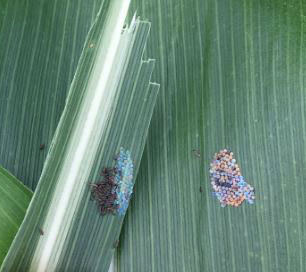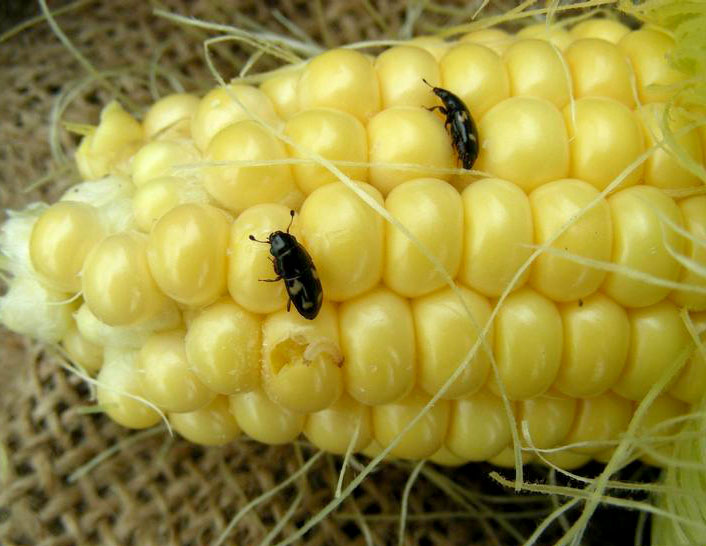Southeast Michigan vegetable update – July 24, 2019
Harvest picks up for many crops, opening farm stands for the season. Look out for sweet corn and cucurbit insects, and diseases in cucumbers, potatoes, and tomatoes.

Weather
Last week’s heat wave has passed, and the weather pattern that closed it out brought thunderstorms, wind and varying amounts of rain. This week should continue to be pleasant. The next chance for rain is early next week. Both the 6-10 and 8-14 day forecasts are calling for slightly higher than normal temperatures and precipitation.
The table below shows rainfall totals for the stations in southeast Michigan, as well as degree-days calculated using the Baskerville-Emin Method. Averages for Commerce and Hudson are over five years, while Deerfield is over three years. Rainfall is in inches. For a refresher on degree-days and how to get this information in your area, see “Accessing growing degree days with Enviro-weather” from Michigan State University Extension.
|
Rainfall and degree day totals as of July 24 |
|||||
|---|---|---|---|---|---|
|
Station |
Degree days (base 42) |
Degree days (base 50) |
5-year degree day average (base 50) |
Rainfall since April 1 |
|
|
Commerce |
2,078 |
1,323 |
1,409.6 |
14.25 |
|
|
Deerfield |
2,294 |
1,491 |
1,694.3 |
16.11 |
|
|
Hudson |
2,158 |
1,392 |
1,515.8 |
14.13 |
|
Crop reports
In cole crops, thrips are being found in very low numbers. On organic farms, another wave of flea beetles are active.
For cucumbers, cantaloupes and watermelons, there have been no reports of downy mildew in our region and the spore trap in Monroe County hasn’t caught any downy mildew spores. Protective fungicides such as chlorothalonil, mancozeb, Gavel or Zing! are the route to go until the disease is confirmed in the area. For more information, see MSU plant pathologist Mary Hausbeck’s article, “Cucumber downy mildew update.” See vine crops note below.
Pepper flowers drop off when nighttime temperatures are above 75 degrees Fahrenheit, so we may have reduced flower number and fruit set after last week’s heat wave. If you are growing in a field with a history of phytophthora, see Hausbeck’s article, “Phytophthora crown rot on cucurbits and peppers requires an aggressive approach.”
For potatoes and tomatoes, late blight has not been found in Michigan. A case of US-23 (Ridomil sensitive) late blight was confirmed in Wood County, Wisconsin (located in the central part of the state). A late blight spore trap in Kent County, Ontario, picked up late blight DNA. With this in mind, keep scouting apply Bravo and Mancozeb weekly.
In pumpkins and winter squash, squash bug is starting to become active. The key to squash bug control is controlling nymphs, so if this is a pest you struggle with later in the season, we are entering the period to scout and treat. Eggs are copper colored and laid in groups; check the underside of the lowermost leaves for masses. Nymphs are green with red legs upon hatching and turn light gray with black legs as they grow. The smaller the nymphs are, the easier they are to deal with. For more information on squash bug, see “Squash bugs as pests of cucurbits in Michigan.” Squash vine borer moths are flying, and larvae can be found the crowns of some wilted plants. See vine crop note below.
Early sweet corn harvest has begun. I am seeing many plantings where maturity is all over the place, a result of spring conditions that resulted in uneven stand emergence.
Corn earworm catches have dropped off, the last major flight happened July 18 and 19. Corn earworm lays eggs on the green silks of any corn, so you may have to adjust your program this year depending on what is around you. The field corn in our region is truly all over the place developmentally—some plantings have brown silks already, while a neighboring planting might only be knee-high. Based on the weather in the next five days, pressure should be low, but check Insect Forecast for the latest estimates. Sprays every five to seven days should be adequate until trap catches pick up again. European corn borer moths are flying in the southern portion of our region, and flight will begin later this week in the northernmost areas of the region.

Another ear pest who is emerging in higher numbers is western bean cutworm. This is a pest that overwinters here, and adults are starting to emerge. I caught 30 moths in a week in Monroe County and 70 in a week in Lenawee County. These trap catches mean growers should scout their pre-tassel sweet corn for egg masses. MSU entomologist Chris Difonzo just released a nice bulletin on identifying the eggs.
The threshold for eggs for fresh market sweet corn is one egg mass per 100 plants. A weekly spray program for corn earworm should control the western bean cutworm post-hatching. Note that if you are growing Bt corn, only Syngenta’s Attribute II trait package has the right Bt protein to kill western bean cutworm larvae, so sprays may be needed depending on your variety.
I’ve also gotten reports of sap beetle, also known as picnic beetles. When you are finding these small, black beetles in the ear, it’s often a sign the ear has been damaged by something else. These beetles are attracted to the smell of decay and usually only become a problem when worms, hale or birds have already damaged the ear. Generally, sprays for other caterpillar pests control sap beetles.

To determine if treatment is warranted, the North Central Integrated Pest Management Center recommends checking 20 ears in five locations in the field. If you’re finding beetles or their larvae and you’re on a regular spray schedule, spray every four to five days if more than 10% of the ears are impacted by sap beetle. If the only pest pressure in a field is from sap beetles and the numbers are at the 10% threshold, two sprays four days apart when three-fourths of the field has fresh silks should be effective.
Last week’s heat wave will affect tomatoes in a couple of ways. High temperatures cause flowers to drop. The extreme heat also will likely mean more blossom end rot. Blossom end rot is the result of not enough calcium reaching the developing fruit, either because there isn’t enough calcium in the soil or (more likely in this case) because the fruit and plant are growing faster than they can move calcium to the developing fruit. Calcium has a hard time moving through plants, so blossom end rot can occur even when there is enough calcium in the soil.
Across all vine crops, last week’s heat wave likely reduced bee activity and pollination. When the weather gets hot, honey bees spend their time on cooling the hive instead of foraging and pollinating flowers. This might mean some weirdly shaped fruit down the line.
When vine crops are flowering and insect pests need to be controlled, it is important to take steps to protect bees. For many pests, growers have a choice between contact insecticides (for example, pyrethroids like Warrior and Mustang) and systemic neonicotinoids (for example, Admire). To protect bees, apply contact insecticides in the evening when flowers are closed. This way, the product is only on the outside of flowers, leaving the inside of the flowers safe for bees. Systemic insecticides move throughout the plant, meaning the material will be present inside the flower, hurting bees.
New tool for temperature inversion and drift prevention
MSU Enviroweather has launched a new tool that can help pesticide applicators gauge the potential for temperature inversions, which can cause pesticide drift. The Temperature Inversion Potential Map is updated every 5 minutes, and the Enviroweather station in Deerfield, Michigan, has been outfitted with the sensors. Sometimes temperature inversions can be seen as a fog, but other times they can’t be, which is where this tool is helpful. Seven Enviroweather stations have been outfitted with two thermometers—one at ground level and one 10 feet in the air. The map tracks the temperatures and displays when there are differences in temperature at ground level and higher in the air, which leads to inversions.
For more information on this tool, see “Enviroweather stations detect low level inversions to help reduce pesticide drift.”
Reach out
Contact me at schuhmar@msu.edu or 517-264-5309 to schedule a farm visit or ask a question.
Meetings
The 2019 MSU Agriculture Innovation Day on July 26 will feature a theme of “Focus on Precision Technology That Pays,” where experts will detail how implementing technology that aids in decision-making can improve yields, increase profit margins and reduce environmental impacts. The free event, which runs from 8:30 a.m. to 5 p.m., features nine field-based sessions focused on specific issues and includes lunch. Meet us at MSU Farms, 3750 College Rd, Lansing, MI 48910!
Start making travel arrangements, the 2019 Great Lakes Fruit, Vegetable, and Farm Market EXPO is scheduled for Dec. 10-12 in Grand Rapids, Michigan. We have great speakers coming in from across the country to address the production, labor and marketing issues affecting Michigan vegetable growers.



 Print
Print Email
Email

